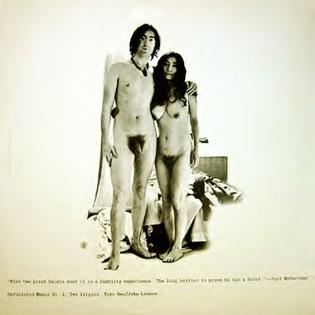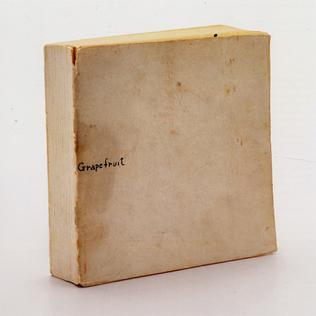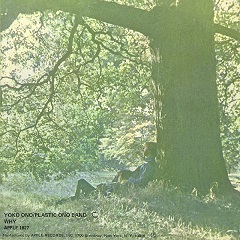Related Research Articles

Yoko Ono is a Japanese multimedia artist, singer, songwriter, and peace activist. Her work also encompasses performance art and filmmaking.
A soprano is a type of classical female singing voice and has the highest vocal range of all voice types. The soprano's vocal range (using scientific pitch notation) is from approximately middle C (C4) = 261 Hz to "high A" (A5) = 880 Hz in choral music, or to "soprano C" (C6, two octaves above middle C) = 1046 Hz or higher in operatic music. In four-part chorale style harmony, the soprano takes the highest part, which often encompasses the melody. The soprano voice type is generally divided into the coloratura, soubrette, lyric, spinto, and dramatic soprano.

Fluxus was an international, interdisciplinary community of artists, composers, designers and poets during the 1960s and 1970s who engaged in experimental art performances which emphasized the artistic process over the finished product. Fluxus is known for experimental contributions to different artistic media and disciplines and for generating new art forms. These art forms include intermedia, a term coined by Fluxus artist Dick Higgins; conceptual art, first developed by Henry Flynt, an artist contentiously associated with Fluxus; and video art, first pioneered by Nam June Paik and Wolf Vostell. Dutch gallerist and art critic Harry Ruhé describes Fluxus as "the most radical and experimental art movement of the sixties".

4′33″ is a modernist composition by American experimental composer John Cage. It was composed in 1952 for any instrument or combination of instruments; the score instructs performers not to play their instruments throughout the three movements. It is divided into three movements, lasting 30 seconds, two minutes and 23 seconds, and one minute and 40 seconds, respectively, although Cage later stated that the movements' durations can be determined by the musician. As indicated by the title, the composition lasts four minutes and 33 seconds and is marked by a period of silence, although ambient sounds contribute to the performance.

Music can be analysed by considering a variety of its elements, or parts, individually or together. A commonly used list of the main elements includes pitch, timbre, texture, volume, duration, and form. The elements of music may be compared to the elements of art or design.

Wedding Album is the third and final in a succession of three experimental albums by John Lennon and Yoko Ono. It followed Unfinished Music No. 1: Two Virgins and Unfinished Music No. 2: Life with the Lions. In Britain, the album was released credited by "John and Yoko", without last names mentioned. In the United States, it was released credited by "John Ono Lennon & Yoko Ono Lennon."

Unfinished Music No. 2: Life with the Lions is the second of three experimental albums of avant-garde music by John Lennon and Yoko Ono, released in May 1969 on Zapple, a sub label of Apple. It was a successor to 1968's highly controversial Unfinished Music No. 1: Two Virgins, and was followed by the Wedding Album. The album peaked in the United States at number 174, 50 places lower than the previous album. The album, whose title is a play on words of the BBC Radio show Life with The Lyons, was recorded at Queen Charlotte's Hospital in London and live at Cambridge University, in November 1968 and March 1969, respectively. The Cambridge performance, to which Ono had been invited and to which she brought Lennon, was Lennon and Ono's second as a couple. A few of the album's tracks were previewed by the public, thanks to Aspen magazine. The album was remastered in 1997.

Unfinished Music No. 1: Two Virgins is the first of three experimental albums released by John Lennon and Yoko Ono on Apple Records. It was the result of an all-night session of musical experimentation with Yoko in John's home studio at Kenwood, while his wife, Cynthia Lennon, was on holiday in Greece. Lennon and Ono's 1968 debut recording is known not only for its avant-garde content, but also for its cover, which shows the couple naked. This made the album controversial to both the public and the parent record company EMI, which refused to distribute it. In an attempt to avoid controversy, the LP record was sold in a brown paper bag, and distributed by Track and Tetragrammaton in the United Kingdom and the United States respectively. Two Virgins, while failing to chart in the UK, reached number 124 in the US. The album was followed six months later by Unfinished Music No. 2: Life with the Lions.
Elend is a dark ambient/neoclassical band formed in France in 1993 by composers and multi-instrumentalists Iskandar Hasnawi of France and Renaud Tschirner of Austria. The band's name is German for "misery." Their music can be described as a combination of contemporary classical music and gothic.

A fermata is a symbol of musical notation indicating that the note should be prolonged beyond the normal duration its note value would indicate. Exactly how much longer it is held is up to the discretion of the performer or conductor, but twice as long is common. It is usually printed above but can be occasionally below the note to be extended.
"Revolution 9" is a sound collage from the Beatles' 1968 self-titled double album. The composition, credited to Lennon–McCartney, was created primarily by John Lennon with assistance from Yoko Ono and George Harrison. Lennon said he was trying to paint a picture of a revolution using sound. The composition was influenced by the avant-garde style of Ono as well as the musique concrète works of composers such as Edgard Varèse and Karlheinz Stockhausen.

The Children's Creativity Museum is an interactive museum for children aged 2–12 years, located in Yerba Buena Gardens, in San Francisco, California. It offers workshops and exhibits that allow children to produce their own media through various interactive, creative processes: stop motion animation, programming robots, music video production, design challenges, art projects, and more. It has around 100,000 museum visitors annually. The Children's Creativity Museum is a nonprofit 501(c)(3) organization, with annual revenues of around $2.1 million, including $600,000 of funding from the city of San Francisco.
Liz Phillips is an American artist specializing in sound art and interactive art. A pioneer in the development of interactive sound sculpture, Phillips' installations explore the possibilities of electronic sound in relation to living forms. Her work has been exhibited at a wide range of major museums, alternative spaces, festivals, and other venues, including the Whitney Museum of American Art, the San Francisco Museum of Modern Art, the Spoleto Festival USA, the Walker Art Center, Ars Electronica, Jacob's Pillow, The Kitchen, and Creative Time. Phillips' collaborations include pieces with Nam June Paik and the Merce Cunningham Dance Company, and her work has been presented by the Cleveland Orchestra, IBM, and the World Financial Center. She is often associated with, and exhibited alongside other early American sound artists Pauline Oliveros, John Cage and Max Neuhaus.

The Israel National Museum of Science, Technology, and Space is a science and technology museum in the city of Haifa, Israel. The museum has approximately 200,000 visitors annually.

Grapefruit is an artist's book written by Yoko Ono, originally published in 1964. It has become famous as an early example of conceptual art, containing a series of "event scores" that replace the physical work of art – the traditional stock-in-trade of artists – with instructions that an individual may, or may not, wish to enact.
Grapefruit is one of the monuments of conceptual art of the early 1960s. She has a lyrical, poetic dimension that sets her apart from the other conceptual artists. Her approach to art was only made acceptable when [people] like Kosuth and Weiner came in and did virtually the same thing as Yoko, but made them respectable and collectible.

"Why" is a song written by Yoko Ono that was first released on her 1970 Yoko Ono/Plastic Ono Band album. In the U.S. it was also released as the B-side of John Lennon's "Mother" single, taken from his John Lennon/Plastic Ono Band album.

"Midsummer New York" is a song written by Yoko Ono that was released as the opening song of her 1971 album Fly and also as the b-side of the single "Mrs. Lennon."

Let me tell you is a song cycle for soprano and orchestra by the Danish composer Hans Abrahamsen. The work was commissioned by the Berlin Philharmonic with support from the Danish Arts Foundation. It is based on the eponymous 2008 novel let me tell you by the writer Paul Griffiths. Its world premiere was given by the soprano Barbara Hannigan and the Berlin Philharmonic under the direction of Andris Nelsons on December 20, 2013.
Kabir Padavali is a song cycle for soprano and orchestra set to the poetry of the Indian mystic Kabir by the American composer Christopher Rouse. The work was commissioned by the Minnesota Orchestra for the soprano Dawn Upshaw. It was first performed by Upshaw and the Minnesota Orchestra under the direction of David Zinman in Minneapolis on January 6, 1999. The piece is dedicated to the composer's son, Adrian Rouse.
The Canta-Concerto is a concerto for mezzo-soprano and orchestra by the American composer Marc Neikrug. The work was commissioned by the New York Philharmonic and was completed in May 2014. It was first performed by the mezzo-soprano Sasha Cooke and the New York Philharmonic under the direction of Alan Gilbert at David Geffen Hall on October 1, 2015. The piece is dedicated to Alan Gilbert.
References
- 1 2 G Douglas Barrett (11 August 2016). After Sound: Toward a Critical Music. Bloomsbury Publishing. pp. 126–. ISBN 978-1-5013-0809-3.
- ↑ Carol Vernallis; Amy Herzog; John Richardson (August 2015). The Oxford Handbook of Sound and Image in Digital Media. Oxford University Press. pp. 159–. ISBN 978-0-19-025817-7.
- ↑ "Grapefruit Slices, by Dinosaur Robot". Dinosaur Robot. Retrieved 2020-07-28.